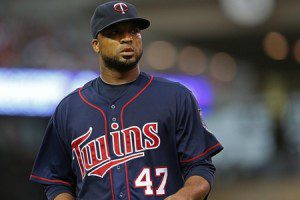
The Twins have finally dealt Francisco Liriano. As of Saturday, Liriano is a member of the Chicago White Sox, and speculation about what sort of return he would fetch can come to a close.
It was very tough to predict what kind of haul the Twins would get for Liriano because he’s been such an enigma. Save maybe A.J. Burnett, Liriano might be the most frustrating pitcher in recent memory. He has legitimate top-of-the rotation stuff including a low- to mid-90s fastball and a devastating slider. Unlike most Twins pitchers, Liriano has been a strikeout machine, sporting a 9.81 K/9 mark and a contact rate of 69.3 percent, the lowest number of any starting pitcher in baseball. Yet, his ERA sits at an ugly 5.31, and his FIP, while better, hovers around league average at 4.22. Despite the struggles, a number of teams at least kicked the tires on Liriano.
Liriano’s upside, combined with the apparent interest throughout the league, combines to make the return for him, Eduardo Escobar and Pedro Hernandez, seem rather disappointing.
Escobar is a 23-year-old infielder, who in 96 PA this season, has not impressed. He’s played mostly as a utility player, hitting a meager .207/.281/.276, a .258 wOBA. His minor league track record doesn’t inspire much confidence. In six seasons, he hit .270/.315/.351 and only once, in A+ ball in 2010, rated as an average hitter in his league. Nevertheless, he has an excellent reputation as a fielder and should be above average at first, second and third. He could have some value as a backup infielder.
Hernandez, a left-hander, has posted strong numbers in the upper minors, but appears to offer very little in the way of upside. He’s almost disturbingly Twins-like, an upper 80s strike-thrower with a good change-up and a meh breaking ball.
At a glance, the scouting report for Hernandez looks quite similar to another recent Twins pickup, Scott Diamond. Diamond (whose pickup was not met with praise from the Twins’ blogosphere) has pitched extremely well for the Twins this season, posting a 2.88 ERA and 3.69 FIP. Diamond, however, is an extreme ground baller. He’s posted a groundout to flyout ratio of 2.81, nearly twice Hernandez’ minor league career mark of 1.43. The flyball tendencies do not bode well for Hernandez, as pitchers with his stuff are generally quite susceptible to home runs.
It’s possible Hernandez could find a home at the back of the Twins rotation, but far more likely that he ends up in relief or as a four-A type.
One has to wonder if the Twins would have been better off had they simply held on to Liriano through seasons’ end. Had they made him a qualifying offer (in the $12.5 million range), they could have collected a sandwich-round pick if he signed elsewhere.
However, Liriano could have accepted the offer and they’d have been stuck with him for another year at a healthy price. We’re a long way into hypotheticals here, but Liriano could end up being a huge bargain or a total disaster on a $12.5 million contract. Had he pitched well, it’s possible he could have recouped some value and netted the Twins a bit more at next season’s deadline. It’s really tough to say if trading him was the right move, but the Twins have, at the very least, rid themselves of a headache.
For Liriano, perhaps a fresh start under pitching whiz Don Cooper will prove fruitful. The White Sox appear to already have a plan in place. It will be interesting to follow the results. Liriano is set to make his Sox debut, pitching to A.J. Pierzynski (whom the Twins traded to acquire Liriano) on Tuesday against the Twins.
